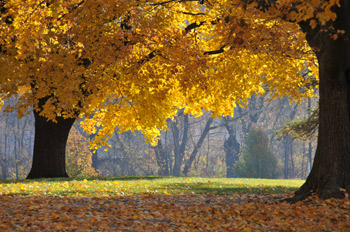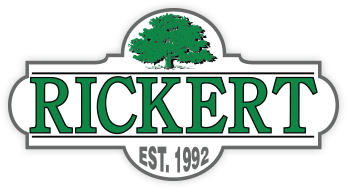Rickert’s General Tree Care Tips
 At Rickert Tree Service we believe that knowing what trees to plant and how to care for them is very important for our customers. Use the information below to help you make informed decisions on the selection and care of the trees on your property.
At Rickert Tree Service we believe that knowing what trees to plant and how to care for them is very important for our customers. Use the information below to help you make informed decisions on the selection and care of the trees on your property.
Benefits of Trees In Your Landscape
- Shade trees can actually save up to 35 percent on your energy bills (called Tree-Based Energy Conservation).
- Shading your east and west windows with deciduous trees will give you shade in the summer & sun in the winter (they lose their leaves in the fall)
- Planting a windbreak with evergreens (conifers) will help hold back icy cold winter winds on the west and northwest sides of your property.
- Planting shade trees over open family use areas such as patios, porches and sidewalks will help for a cooler outdoor space in the summer.
- Shading your air conditioning unit with shrubs or trees will help keep it cooler so it runs more efficiently
Selecting shade and ornamental trees for the yard
Trees are like people with different personalities, habits and appearances, so we can’t recommend one ‘best’ tree that will look fantastic or complement existing landscape in every yard, but the keep the following information will help you in selecting the right tree for your property:
Autumn Brilliance Maple trees, with their brightly colored orange and red foliage, can live to well over 100 years of age, but they are extremely slow growing – and they find Oklahoma’s extremely hot summers, droughts and icy winters a real challenge. (You’ll recognize them by their seeds that look like a pair of wings or like little helicopters as they fall.)
Tall maples (Red Maple, Silver Maple, Sugar Maple and others) grow to as high as 50′ or higher. Medium-sized maples (Japanese Red Maple is one) grow up to 25′. Dee Nash, Oklahoma Gardening Examiner, recommends the Autumn Fantasy Maple, which grows faster than other red maples.
Other shade and ornamental trees include Beech, Catalpa, Sycamore, Cottonwood and the Oak trees, all of which can be quite high at 60′ to 80′.
Fruit trees grace our neighborhoods and countryside in Spring with beautiful, fragrant blossoms. Even the dwarf varieties can often produce juicy, good fruit. Some fruit trees that do not fertilize hold the distinction of not causing reactions in people with tree allergies.
Apple, Peach, Plum, Pear, Cherry and Apricot grow to a 3′ to 4′ height. In dwarf sizes, they’ll grow up to 3′.
Flowering trees add gorgeous color to our neighborhoods all through summer, right into autumn. They are usually of small to medium height (up to 40′) and include Crab Apple, Serviceberry, Eastern Redbud, Oklahoma Redbud, various Dogwoods, Magnolias, Chinese Pistache, the American Smoketree, and Dee Nash’s recommended Arnold Promise Witch Hazel. You might also add a shrub that glorifies the color-less winter landscape at the first sign of Spring – the bright yellow Forsythia. And don’t forget the many varieties and colors of the most popular shrub of the South, the Crapemyrtle. We’ve been told the Eastern Redbud is easier to grow and has fewer ‘problems’, the better choice of Redbuds.
Planting Tips
Spring and early Fall are typically the best times to plant trees. In the northerly, colder areas of the United States, Spring is best. In the southern states like Oklahoma, planting in late Spring is not recommended because of the high temperatures.
The biggest mistake people make when planting trees is planting too deep or with too narrow a hole. The hole width should be three times the diameter of the root spread or root ball. The depth of the hole should be slightly more shallow than the root ball.
- Always roughen up the sides of the hole. Don’t attempt to have smooth hole sides.
- Shorten exceptionally long roots.
- Do not cover the root crown (the top of the root structure) with soil. It should be exposed when you are done planting.
- If you are planting a tree with a root ball wrapped in burlap, pull back or remove the burlap. Remove string and twine.
- Add peat moss, composted manure or topsoil or a combination of them to fill the hole around the tree to the top of the root ball, or a little bit lower to permit settling. Do not pat down or compress this filler soil.
- If you are planting a tree from a container, completely remove the container even if it is made of fiber. If the roots of the tree are tightly wound, loosen them up and spread them out to allow moisture and oxygen to reach them. Add the original soil. Lightly compress the soil, being careful not to tamp it down hard.
- Planting a bare-rooted tree is quite different, as it has no soil and generally its roots are not wound together. Plant it immediately after removing it from its original spot. In the planting hole, build a mound or cone of dirt in the middle, then seat the tree and spread the roots over the mound. The roots and top of the root structure should meet about two inches above the soil level to allow for settling.
- Build a basin around the root ball and fill it several times to water the tree deeply.
- Stake the tree loosely using two stakes, one on each side, and non-abrasive ties. Remove the stakes when the tree can stand upright on its own (up to a year).
- Mulch! Mulch! Mulch! This is so important. Cover the whole area except for a small circle around the base of the tree trunk, with up to four inches of bark, pine needles, leaves or wood chips.
Pruning Tips
Prune your fruit tree with its natural growing pattern in mind to help ensure that it produces good quality fruit each year. In other words, if it is shown as a tree that spreads out, allow it to spread out. If it is naturally a tree that grows up with not so much spreading out, allow that to happen.
- Prune early when the tree is young, but no earlier than the third year.
- Prune low hanging branches. If it is not removed, a branch that is 3′ from the ground now will still be 3′ from the ground when the tree is fully grown. (It will be bigger.)
- Where two branches vie for the same space and light, perhaps rubbing together against each other, cut out one of them.
- Thin the branches to create even spacing.
- Cut out sprouts that quickly grow along the base of the tree.
Contact Rickert Tree Service today to get a free estimate.






